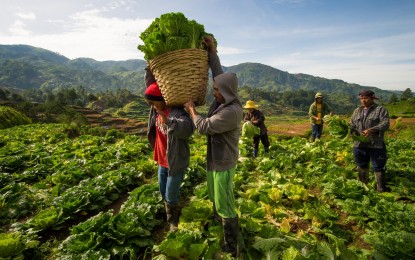
(Photo courtesy of the Department of Agriculture)
MANILA – Several agricultural groups have urged local government units (LGUs) to prioritize production support and post-harvest investments for agriculture and fisheries in 2022.
This, as the sector anticipates the full implementation of Mandanas ruling which enabled the provision of funds to LGUs from "collections of national taxes".
The Mandanas ruling states that national taxes for inclusion in the base of the just share of LGUs shall include, the national internal revenue taxes enumerated in Section 21 of the National Internal Revenue Code, as amended, collected by the Bureau of Internal Revenue and the Bureau of Customs; Tariff and customs duties collected by the Bureau of Customs; 50 percent of the value-added taxes collected in the Autonomous Region in Muslim Mindanao (ARMM), and 30 percent of all other national taxes collected in ARMM.
On Tuesday, the Philippine Council of Agriculture estimated that the ruling will lead to a PHP234.6 billion expected increase in the National Tax Allotment of LGUs by FY 2022 based on computations by the Department of Finance.
As such, food security advocate Tugon Kabuhayan urged LGUs to focus on the use of additional resources for farmers and fisherfolk to increase their production by investing more in post-harvest facilities.
“We suggest that 10 percent of the funds or PHP23.4 billion be allocated for this (post-harvest facilities) annually, especially in the countryside where most production is happening. The allocation can be adjusted once LGUs reach the desired production and post-harvest losses targets,” it said.
Increase production coupled with lower post-harvest losses will not only benefit the countryside. Done properly, metropolitan cities will share the benefit in terms of availability of fresh, nutritious food at affordable prices, it added.
The group said local producers are more than capable of addressing the country’s need for accessible and affordable food. Local producers just need facilities and systems that support production and post-harvest facilities that ensure that whatever is produced is not wasted.
Address post-harvest, food losses issue
Meanwhile, Philippine Center for Postharvest Development and Mechanization (PhilMech) Executive Director Baldwin Jallorina believes farmers' and fisherfolk's profit need to be increased.
Addressing the issues on post-harvest and food losses should be prioritized, he said.
“In the Philippines, postharvest losses of commodities represent a very significant loss of 10 to 50 percent of production output in developing countries. This means that 10 percent to 50 percent of all the land, inputs, and labor used to produce the commodities go to waste. And it also means that all of us here, involved in this summit, have a lot of work to do,” Jallorina said.
“If we can curb at least 1 percent of the losses at a time, by generating appropriate and problem-oriented technologies and system for our farmers and stakeholders, then we can transform losses into profits, thereby achieving Masagang Ani at Mataas na kita for our farmers,” he added.
Department of Agriculture (DA) Undersecretary Evelyn Laviña, during the recently concluded food summit, said they are aiming for high level of food production efficiency in their strategies.
Data from the Philippine Statistics Authority recorded that losses in rice range were as high as 25 percent more than 10 years ago, and are now between 10 percent to 20 percent. This as PHilMech accelerated the application of post-harvest interventions in the rice industry. (PNA)
